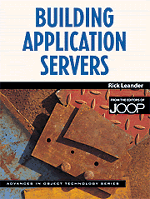Book contents
- Frontmatter
- Contents
- acknowledgements
- Introduction
- PART 1 ARCHITECTURE
- PART 2 DESIGN
- PART 3 PROGRAMMING
- Chapter 8 Implementing an Application Server Framework
- Chapter 9 Using Java to Build Business Objects
- Chapter 10 Persistent Objects: Communicating with Databases
- Chapter 11 Interfaces and Client-Side Communication
- Chapter 12 Enforcing Business Rules
- Chapter 13 Multiprocessing, Concurrency, and Transactions
- Chapter 14 The Next Generation of Business Applications
- Appendix: Setting up a Development Environment
- Index
Chapter 11 - Interfaces and Client-Side Communication
from PART 3 - PROGRAMMING
Published online by Cambridge University Press: 06 July 2010
- Frontmatter
- Contents
- acknowledgements
- Introduction
- PART 1 ARCHITECTURE
- PART 2 DESIGN
- PART 3 PROGRAMMING
- Chapter 8 Implementing an Application Server Framework
- Chapter 9 Using Java to Build Business Objects
- Chapter 10 Persistent Objects: Communicating with Databases
- Chapter 11 Interfaces and Client-Side Communication
- Chapter 12 Enforcing Business Rules
- Chapter 13 Multiprocessing, Concurrency, and Transactions
- Chapter 14 The Next Generation of Business Applications
- Appendix: Setting up a Development Environment
- Index
Summary
A service interface is a set of consistent, easy-to-use application services that can be called by user interface programmers to perform the tasks requested by the user. When the post transaction button is clicked, the user interface calls the post transaction service, supplying the relevant data items. The user interface programmers have no need to know how the transaction is posted; they simply need to know how to request the appropriate post transaction service.
Once the data is supplied to the service interface, it is up to the application server programmer to ensure that the necessary business objects are retrieved by the persistent object layer and that methods are called to perform all of the tasks requested by the service interface specification. If the business objects are designed correctly and the persistence layer can correctly retrieve the business objects, programming the service interface should not be a difficult task.
What complicates service interface programming is the additional layers of middleware managing objects distributed over a number of different computers. This restricts the amount of data that can be passed between the client and the service interface, since much of the data must be passed through network connections and be marshaled to meet the requirements of the remote machine's data format. The network also adds a multitude of new exception and error conditions that must be anticipated. As an added restriction, the same service may be executing simultaneously for a large number of different clients, each requesting services for any number of different sets of data.
This chapter will examine these technical requirements and explore some of the programming techniques available to address these challenges.
- Type
- Chapter
- Information
- Building Application Servers , pp. 269 - 296Publisher: Cambridge University PressPrint publication year: 2000

